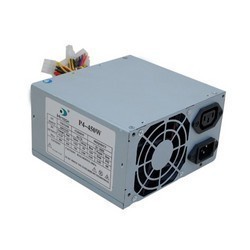SMPS Power Supply
An SMPS (Switched-Mode Power Supply) is a device that provides power to motherboards in small electronic devices such as laptops and mobile devices. It is often used in situations that require small or light weight components, where an ATX power supply would not be suitable. An SMPS is also capable of a much more efficient transfer of energy, as it is capable of managing voltage and current levels by switching between on and off at fast speeds, rather than simply dissipating extra voltage like ATX power supplies do.
Applications
Many different devices use SMPSs, especially when efficiency, size, or weight is a prime concern. For example, laptops and high end mobile devices often use SMPSs because they are not large enough to hold other types of power supplies. Some forms of laboratory equipment also use SMPSs in order to allow the user to adjust the voltage levels that the device is using. Additionally, some types of personal desktop computers, including computers that use ATX motherboards, use SMPSs, though SMPSs are rarely used for this purpose.
Advantages
SMPSs are advantageous because they are able to manage electricity with very little waste. While ATX power supplies must remain on at all times and dissipate extra voltage levels that they do not need, SMPSs are able to simply turn themselves off when they do not need more voltage and turn themselves back on when they need more voltage. SMPSs are also much smaller than other types of power supplies and, therefore, do not require the additional space that other power supplies do.
Disadvantages
While SMPSs are advantageous, they also have several disadvantages. For example, SMPSs are very complex and cannot be repaired as easily as an ATX power supply. SMPSs can also generate large amounts of electrical noise if it is not heavily suppressed and may have a poor power factor if designed or installed improperly.


Comments - One Response to “SMPS Power Supply”
Sorry but comments are closed at this time.